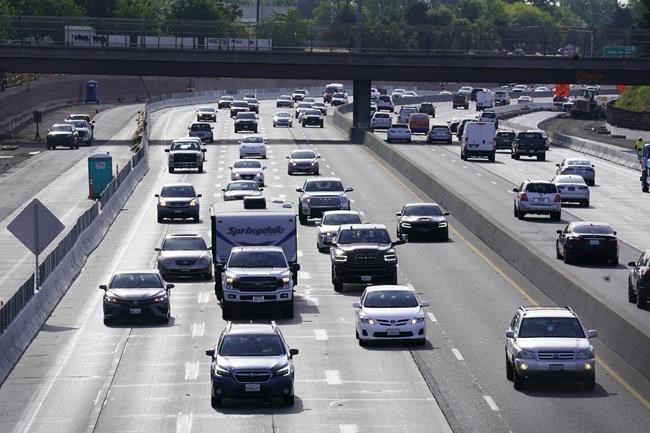SACRAMENTO, Calif. (AP) — California wants electric vehicle sales to triple in the next four years to 35% of all new car purchases, an aggressive target set as part of the goal to phase out the sale of gas-powered cars by the middle of next decade.
The California Air Resources Board's proposal would slowly raise the sale of new cars that are electric, hydrogen-powered or plug-in hybrids to 100% by 2035. About 11% of all new passenger car sales nationally happen in California, giving the state significant influence over the auto market. Californians would still be allowed to drive gas-powered cars and sell used ones, meaning planet-warming emissions will still spew from the state's roadways.
The hoped-for boost in electric vehicle sales will also require a major increase in charging stations. California has set a goal of 250,000 charging stations by 2025, and right now there are fewer than 80,000 stations in public spaces or in parking lots at office buildings, apartment buildings and other shared spaces. The California Energy Commission last year approved spending $314 million over three years for passenger car charging stations and Newsom added more in his proposed state budget.
The release kicks off a months-long state review process and the plan requires approval from the U.S. Environmental Protection Agency. The state is unlikely to face resistance from a Democratic White House. The Biden administration recently restored California's power to set its own vehicle emissions standards under the Clean Air Act and the president has committed $5 billion to build more charging stations around the country.
A group representing the auto industry said meeting the requirements will be “extremely challenging.”
Passenger vehicles contribute about a quarter of the state's total greenhouse gas emissions — more than any other single source, according to the air board. The program is one part of California’s efforts to drastically reduce carbon emissions. Between 2026 and 2040, state experts estimate the program would lower emissions by nearly 384 million metric tons of carbon dioxide equivalent. That’s a little less than all emissions across California's economy in a single year.
Elsewhere, Washington Gov. Jay Inslee signed a law last month setting a goal of requiring all new vehicles in the state to be electric by 2030, but regulators have until the end of 2023 to say how the state will get there.
California's rules would require 35% of new car sales for model year 2026 to be zero-emission vehicles, including battery or hydrogen powered, or plug-in electric hybrids. That's a sharp increase from 2021, when about 12% of all cars sold in the state were zero-emission, according to the air board. About 1 million of the 26 million cars currently on California roads are zero-emission.
That requirement ramps up to 100% of all new sales by 2035. Up to 20% of sales by 2035 could be plug-in hybrids that run on a combination of battery and gas power, though the regulations boost how far such cars must be able to travel on battery power alone.
Automakers including Ford and Toyota deferred to the Alliance for Automotive Innovation for a statement on the proposal. The group says the industry is “committed to electrification and a net-zero carbon transportation future" but raised questions about the drastic ramp up in the required zero-emission vehicle sales.
“Automakers will certainly work to meet whatever standards are eventually adopted, but these draft requirements will be extremely challenging even in California and may not be achievable in all the states that currently follow California’s program," the group said.
Nine states follow California's current zero-emission vehicle rules, which set rules through model year 2025, and five states plan to join in future years. If the federal government approves California's new plan, the other states would have to decide whether to follow suit. New York also aims to phase out gas powered vehicles by 2035.
The regulations also require electric vehicles to get at least 150 miles (241 kilometers) per charge, up from 50 miles (80 kilometers), though most manufacturers exceed that. They establish an eight-year or 100,000-mile (161,000-kilometer) battery warranty.
All 17 carmakers that sell in California would be required to hit the 35% sales mark. But there is wiggle room. California's existing electric vehicle standards let companies save credits if they sell a higher percentage of electric cars than required, and those credits can be used later to meet sales goals.
Companies can also make deals with each other to count each other’s sales as their own. Electric-vehicle maker Tesla has made such deals with many automakers in the past, state officials said.
Some environmental groups said the state should set an even more aggressive timeline, arguing heavily polluted communities can't wait, and make it easier for low-income people to purchase electric vehicles.
“There’s no excuse for California to take the slow road to an all-electric future when we’re being gouged at the gas pump and facing epic drought and wildfires," said Scott Hochberg a transportation attorney for the Center for Biological Diversity’s Climate Law Institute.
___
Associated Press journalist Tom Krisher in Detroit contributed.
___
This story was first published on April 13, 2022. It was updated on April 14, 2022 to correct the amount of carbon dioxide equivalent expected to be eliminated by the rules. That number is 384 million metric tons of carbon dioxide equivalent from 2026 to 2040, not the amount that will be saved annually.
Kathleen Ronayne, The Associated Press



